
Answer the following questions about levonorgestrel (trade name Plan B). Levonorgestrel interferes with ovulation, the release of an egg from an ovary, so it prevents pregnancy if taken within a few days of unprotected sex.
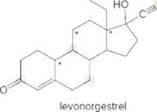
- Identify the
functional groups. - How many C’s does levonorgestrel contain?
- How many H’s are present at each C labeled with an asterisk (*)?
- Give the shape around each atom labeled in gray.
- Label all polar bonds.
- Is levonorgestrel soluble in an organic solvent?
- Is levonorgestrel soluble in water?
(a)
Interpretation:
The functional group in levonorgestral should be identified.
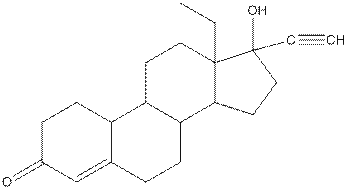
Concept Introduction:
Functional groups are the atoms or group of atoms that gives chemical properties to an organic compound and also chemical reactivity centre. Examples of functional groups are aldehyde, ketone, alcohol, alkene, alkyne etc.
Answer to Problem 84P
The functional groups present in the compound are alcohol, ketone, alkene and alkyne.
Explanation of Solution
Functional groups are the atoms or group of atoms that gives chemical properties to an organic compound and also chemical reactivity centre. Structures of different functional groups are as follows:

In the above functional group R represents an alkyl group.
In functional group ketone carbonyl carbon is bonded to two alkyl groups, in aldehyde carbonyl carbon is attached to one alkyl group and one hydrogen atom, in alcohol functional group an −OH is bonded to an alkyl group, in alkyne there is a triple bond between two carbon atoms and in alkene there is a double bond between two carbon atoms.
Levonorgestral structure is as follows:
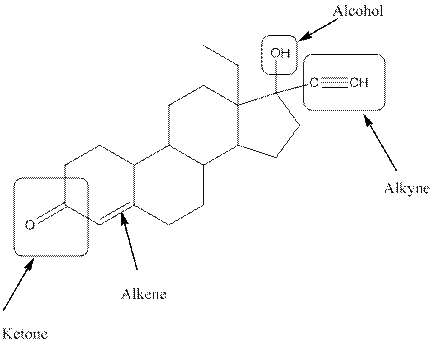
Observe the structure of Levonorgestral. As indicated in the above figure, four types of functional groups present that is, alkene, alkyne, alcohol and ketone. The functional groups present in the compound are alcohol, ketone, alkene and alkyne.
(b)
Interpretation:
The number of carbon atoms in the structure of levonorgestral should be determined.
Concept Introduction:
In skeletal structure the terminals represent methyl
Answer to Problem 84P
Twenty one carbon atoms present in the compound.
Explanation of Solution
The structure of Levonorgestral is as follows:
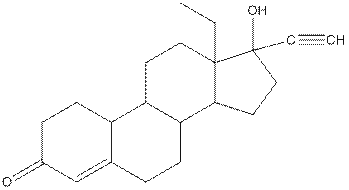
In skeletal structure the terminals represent methyl
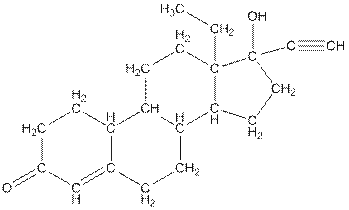
Hence, twenty one carbon atoms present in the compound.
(c)
Interpretation:
The number of hydrogen atoms present in the * carbon atoms in levonorgestral should be determined.
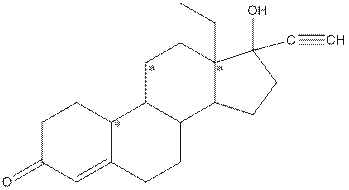
Concept Introduction:
In skeletal structure the terminals represent methyl
Answer to Problem 84P
Number of hydrogen atoms in * carbon atoms are three.
Explanation of Solution
Complete structure of levonorgestral is as follows:
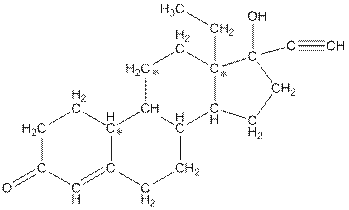
From the complete structure of Levonorgestral, it is clear that number of hydrogen atoms in * carbon atoms are three.
(d)
Interpretation:
The shape around each indicated carbon atom in levonorgestral should be determined.
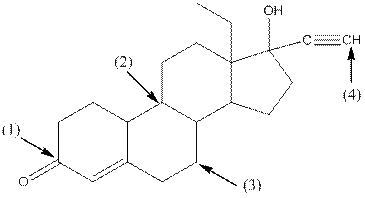
Concept Introduction:
The following table should be used while determining the shape around an atom.
| Number of groups | Number of atoms | Number of lone pairs | Shape | Bond angle |
| 2 | 2 | 0 | Linear | |
| 3 | 3 | 0 | Trigonal planar | |
| 4 | 4 | 0 | Tetrahedral | |
| 4 | 3 | 1 | Trigonal pyramidal | |
| 4 | 2 | 2 | Bent |
Answer to Problem 84P
Shape around carbon 1 is trigonal planar, shape around carbon 2 is tetrahedral, shape around carbon 3 is tetrahedral and shape around carbon 4 is linear.
Explanation of Solution
Given compound is as follows:
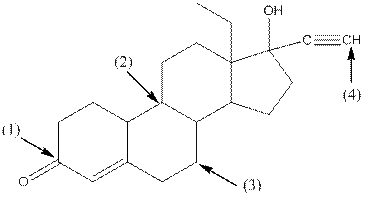
Complete structure of the compound is as follows:
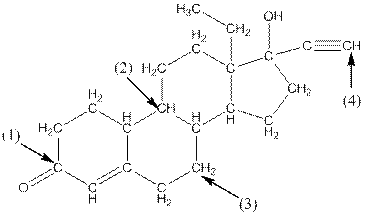
- Around C1, three atoms (two carbon and one oxygen) present. So, shape around carbon 1 is trigonal planar.
- Around C2, four atoms (three carbon and one hydrogen) present. So, shape around carbon 2 is tetrahedral.
- Around C3, four atoms (two carbon and two hydrogen) present. So, shape around carbon 3 is tetrahedral.
- Around C4, two atoms ( one carbon and one hydrogen) present. So, shape around carbon 4 is linear.
(e)
Interpretation:
All the polar bonds in levonorgestral should be labeled.
Concept Introduction:
The unequal sharing of valence electrons in a bond is called polar bond. Polar bond result when the bond formed between two atoms in which one atom is more electronegative than the other one. One example of polar bond is
Structure of HCl is as follows:

In
Answer to Problem 84P
The structure of levonorgestral with labeled all polar bonds is as follows:
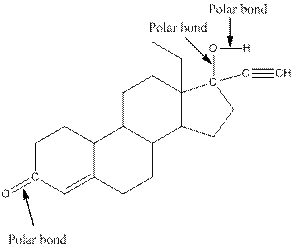
Explanation of Solution
In organic compound, most of the polar bonds formed between carbon and heteroatoms like oxygen, nitrogen, sulphur etc.
In the compound, three polar bonds present. One polar bond is between carbon and oxygen where oxygen is more electronegative than carbon. Second polar bond is between carbon and oxygen where oxygen is more electronegative than carbon and third polar bond is between oxygen and hydrogen where oxygen is more electronegative than hydrogen.
The structure of levonorgestral with labeled all polar bonds is as follows:
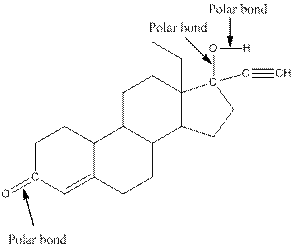
(f)
Interpretation:
Whether levonorgestral is soluble in organic solvent or not should be determined.
Concept Introduction:
A compound is soluble in organic solvent if the compound contains too many hydrocarbon bonds that is if it is non-polar.
Answer to Problem 84P
The compound levonorgestral will soluble in organic solvent.
Explanation of Solution
The complete structure of levonorgestral is as follows:
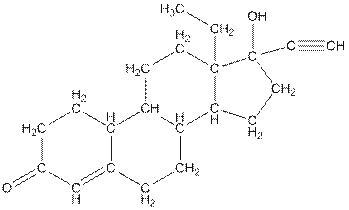
The compound levonorgestral has too many carbon hydrogen bonds. So, the compound will soluble in organic solvent.
(g)
Interpretation:
Whether levonorgestral is soluble in water or not should be determined.
Concept Introduction:
Water is a polar solvent. To dissolve in water the compound must be polar. Polar compound is that compound in which polar bonds are present. The unequal sharing of valence electrons in a bond is called polar bond. Polar bond result when the bond formed between two atoms in which one atom is more electronegative than the other one. One example of polar bond is
Structure of HCl is as follows:

In
Answer to Problem 84P
The compound levonorgestral is water soluble.
Explanation of Solution
Structure of levonorgestral is as follows:
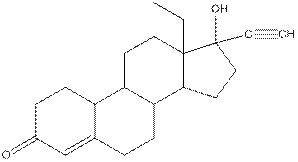
In the compound levonorgestral, two oxygen heteroatoms present. These heteroatoms can form hydrogen bonds with water molecule and hence, the compound is soluble in water.
Want to see more full solutions like this?
Chapter 11 Solutions
General, Organic, and Biological Chemistry - 4th edition
- Nonearrow_forward3. A molecular form of "dicarbon", C2, can be generated in gas phase. Its bond dissociation energy has been determined at 599 kJ/mol. Use molecular orbital theory to explain why energy of dissociation for C₂+ is 513 kJ/mol, and that for C2² is 818 kJ/mol. (10 points)arrow_forward9.73 g of lead(IV) chloride contains enough Cl- ions to make ____ g of magnesium chloride.arrow_forward
- 6. a) C2's. Phosphorus pentafluoride PF5 belongs to D3h symmetry group. Draw the structure of the molecule, identify principal axis of rotation and perpendicular (4 points) b) assume that the principal axis of rotation is aligned with z axis, assign symmetry labels (such as a1, b2, etc.) to the following atomic orbitals of the P atom. (character table for this group is included in the Supplemental material). 3s 3pz (6 points) 3dz²arrow_forward2. Construct Lewis-dot structures, and draw VESPR models for the ions listed below. a) SiF5 (4 points) b) IOF4 (4 points)arrow_forward5. Complex anion [AuCl2]¯ belongs to Doh symmetry point group. What is the shape of this ion? (4 points)arrow_forward
- 4. Assign the following molecules to proper point groups: Pyridine N 1,3,5-triazine N Narrow_forward7. a) Under normal conditions (room temperature & atmospheric pressure) potassium assumes bcc lattice. Atomic radius for 12-coordinate K atom is listed as 235 pm. What is the radius of potassium atom under normal conditions? (3 points) b) Titanium metal crystallyzes in hcp lattice. Under proper conditions nitrogen can be absorbed into the lattice of titanium resulting in an alloy of stoichiometry TiNo.2. Is this compound likely to be a substitutional or an interstitial alloy? (Radius of Ti (12-coordinate) is 147 pm; radius of N atom is 75 pm. (3 points)arrow_forwardcan someone answer the questions and draw out the complete mechanismarrow_forward
 Introduction to General, Organic and BiochemistryChemistryISBN:9781285869759Author:Frederick A. Bettelheim, William H. Brown, Mary K. Campbell, Shawn O. Farrell, Omar TorresPublisher:Cengage Learning
Introduction to General, Organic and BiochemistryChemistryISBN:9781285869759Author:Frederick A. Bettelheim, William H. Brown, Mary K. Campbell, Shawn O. Farrell, Omar TorresPublisher:Cengage Learning Chemistry: An Atoms First ApproachChemistryISBN:9781305079243Author:Steven S. Zumdahl, Susan A. ZumdahlPublisher:Cengage Learning
Chemistry: An Atoms First ApproachChemistryISBN:9781305079243Author:Steven S. Zumdahl, Susan A. ZumdahlPublisher:Cengage Learning ChemistryChemistryISBN:9781305957404Author:Steven S. Zumdahl, Susan A. Zumdahl, Donald J. DeCostePublisher:Cengage Learning
ChemistryChemistryISBN:9781305957404Author:Steven S. Zumdahl, Susan A. Zumdahl, Donald J. DeCostePublisher:Cengage Learning
 Introductory Chemistry: A FoundationChemistryISBN:9781337399425Author:Steven S. Zumdahl, Donald J. DeCostePublisher:Cengage Learning
Introductory Chemistry: A FoundationChemistryISBN:9781337399425Author:Steven S. Zumdahl, Donald J. DeCostePublisher:Cengage Learning





